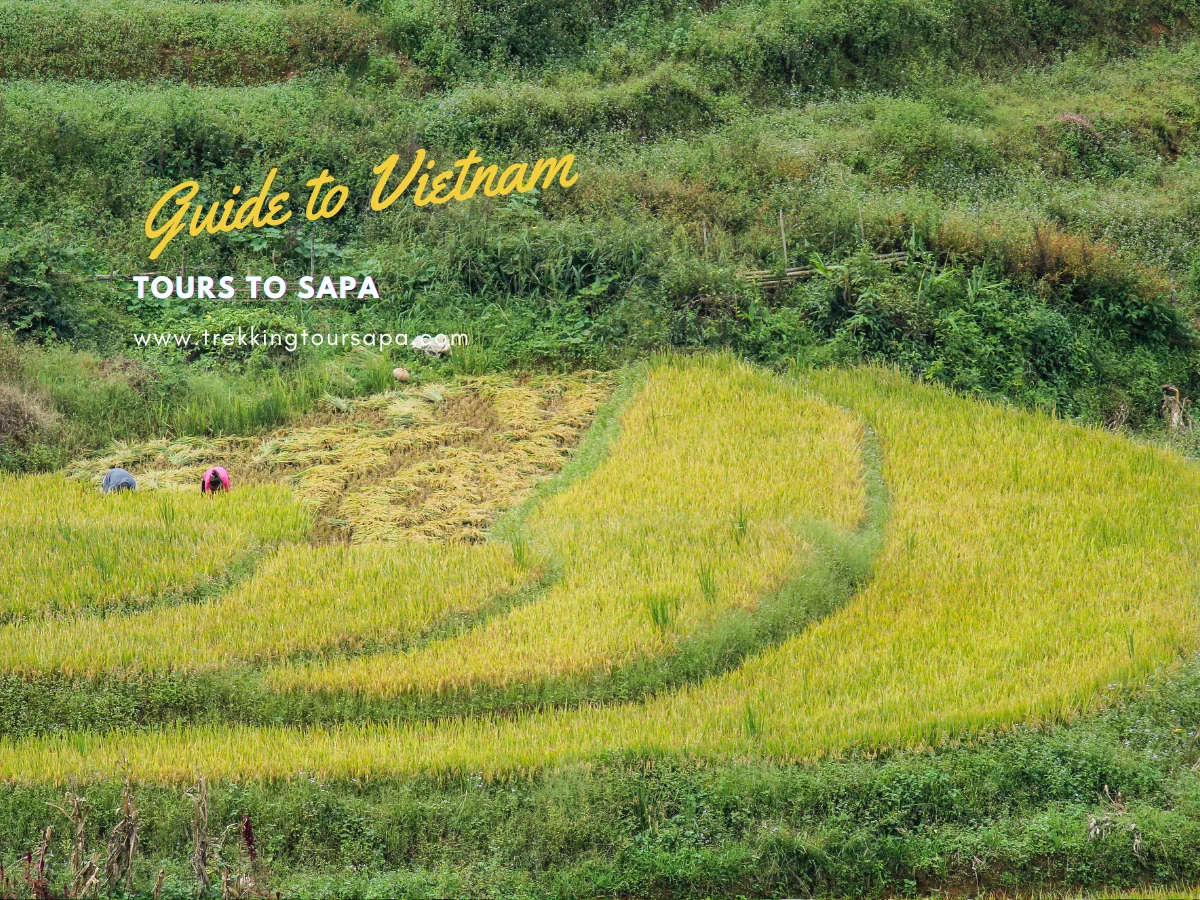Sapa is a beautiful town in northern Vietnam. It’s famous for its stunning landscapes and rich culture. It offers amazing trekking adventures that make tours to Sapa unforgettable.
As we explore Sapa, we’ll see lush rice terraces and vibrant markets. We’ll also meet friendly ethnic communities. From the O Quy Ho Pass to the delicious salmon and sturgeon, Sapa will amaze us.
Key Takeaways
- Sapa is about 300 kilometers from Hanoi, making it easy to get to.
- Visitors can see landmarks like the Sapa Stone Church and lively markets.
- The best time to visit is October to November for golden terraces and cool weather.
- Adventurous travelers can climb Fansipan Peak, the highest in Indochina.
- Sapa is home to diverse ethnic minorities with unique cultures.
- There are luxury resorts and authentic homestays to stay in.
- Supporting local communities by buying handicrafts is encouraged.
Table of Contents
ToggleOverview of Sapa

Sapa is a top travel spot in Vietnam, perfect for weekend getaways from Hanoi. It’s about 300 kilometers away from the city’s noise. This town offers stunning views and a chance to learn about different cultures.
The air in Sapa is cool and refreshing. It invites you to explore and see the area’s beauty. Our Sapa travel guide shows it’s a great place for those who love adventure, especially trekking.
Here, you can trek through beautiful terraced rice fields and valleys. It’s a way to connect with nature and learn about local traditions. The area is home to many ethnic groups, like the H’Mong and Dao, making cultural experiences rich and diverse.
Many people go on trekking tours in Sapa to see it all up close. These tours let you see amazing views and dive into Sapa’s culture. For more tips on planning your trip, check out this Sapa travel guide.
Geography and Location
Sapa is about 350 kilometers (217 miles) northwest of Hanoi, in Lào Cai Province. It’s in the Hoàng Liên Son mountain range, at about 1,500 meters (4,921 feet) high. From here, you can see the stunning Muong Hoa Valley and its famous terraced rice fields.
These fields are not just beautiful. They also hold deep cultural meaning for the local ethnic communities. They shape the area’s beauty and history.
The area around Sapa is full of different plants and animals. You can see amazing waterfalls like Silver Waterfall and Love Waterfall. These waterfalls make the landscape even more magical.

Don’t miss Fansipan, the highest mountain in Vietnam. It’s a key part of the Hoàng Liên Son Mountain Range.
Sapa has a cool climate, unlike most of Vietnam. It has cool summers and cold winters. This weather is perfect for outdoor activities like trekking, hiking, and camping.
Exploring Sapa also lets you learn about the Hmong and Dao communities. Their culture adds a rich layer to the area’s beauty.
Weather and Best Time to Visit
Sapa has a temperate Sapa climate with four seasons. Each season brings something special for travelers. Knowing when to go can make our trip better.
The best times are spring from March to May and autumn from September to November. Spring is full of flowers and greenery, with temperatures between 10°C and 20°C. Autumn shows off golden rice terraces, with temperatures from 15°C to 20°C.
Let’s take a closer look at what each season offers:
| Season | Temperature Range (°C) | Highlights |
|---|---|---|
| Spring (March – May) | 10°C – 20°C | Lush greenery & blooming flowers |
| Summer (June – August) | 17°C – 24°C | Heavy rainfall with fewer tourists |
| Autumn (September – November) | 15°C – 20°C | Golden rice fields & harvest season |
| Winter (December – February) | 0°C – 10°C | Occasional snowfall & colder temperatures |
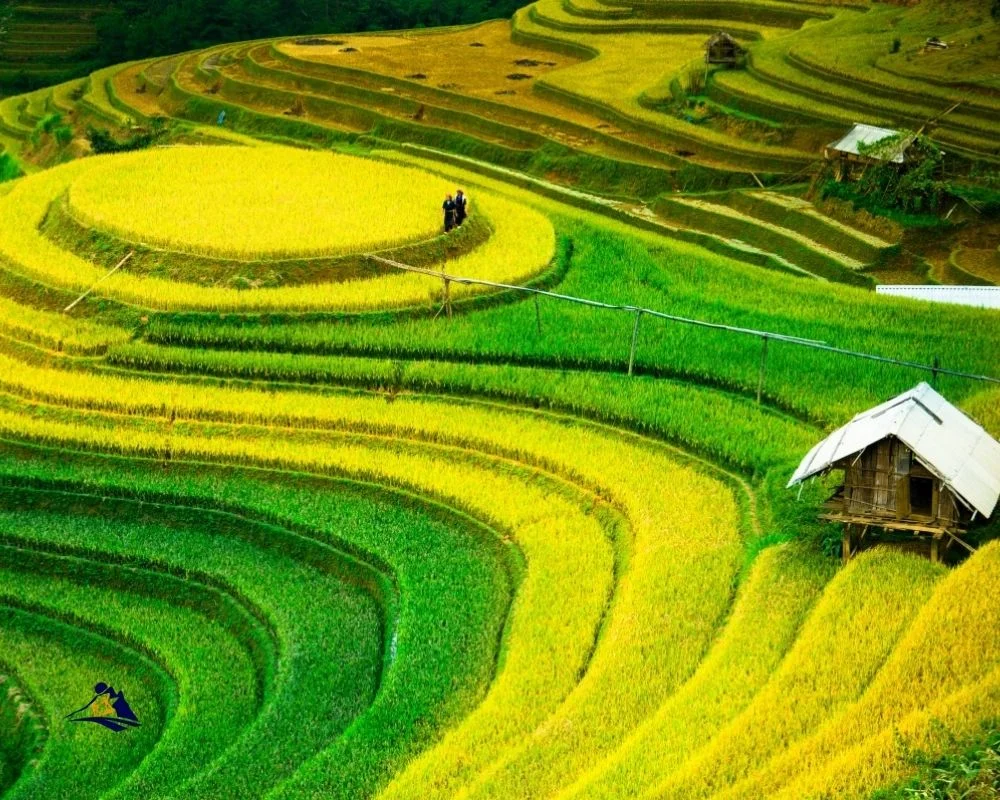
The summer months are the peak tourist time. Off-peak is from November to March, offering a calm atmosphere and lower prices. Shoulder seasons, March to May and September to November, have mild weather and reasonable prices.
Remember, the best time to visit Sapa is in spring and autumn. These seasons offer the best experiences for exploring and enjoying.
Cultural Diversity
Sapa is a vibrant tapestry of traditions and lifestyles. It showcases significant Sapa cultural diversity. The region is home to many ethnic minorities, like the H’mong, Dao, Tay, Giay, and Xa Pho communities.
Each group brings their own languages, traditional clothing, and customs. Visiting local villages lets us engage with these diverse cultures. It gives us a genuine insight into their daily lives and practices.
One of the most remarkable aspects of Sapa’s cultural diversity is the array of festivals celebrated throughout the year. Events like the Love Market in February and the Sapa in Cloud Festival in April attract travelers. These cultural festivities offer a fantastic opportunity to interact with locals, witness traditional performances, and participate in age-old rituals.
The culinary scene in Sapa mirrors its cultural richness. It presents dishes that tell the story of the land and its people. Local specialties such as thang co (horse meat hotpot) and com lam (bamboo-cooked rice) showcase the flavors of the region’s diverse ethnic groups.
In summary, exploring Sapa offers a deep dive into its cultural diversity. We can learn from the rich traditions and histories of the ethnic minorities in Sapa. This engagement preserves their stories and fosters a deeper understanding of what makes this region truly special.
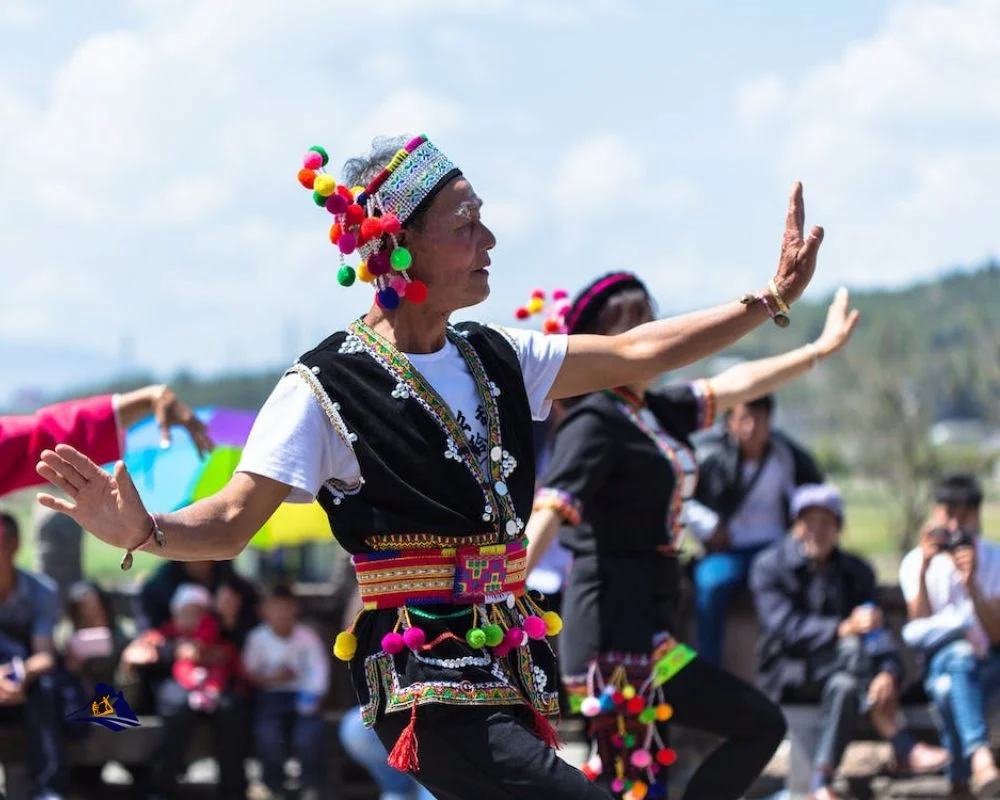
Getting to Sapa
Traveling to Sapa offers many options for everyone. The most common way is by train from Hanoi to Lào Cai. Then, a scenic drive of about 38 kilometers takes us up into the mountains. Trains run from 21:00 to 22:00 daily, making overnight travel easy. Ticket prices are from VND 500,000 to 1,000,000 (around US$20-40), offering a peaceful journey.
For a more direct route, bus services are available. Some buses are sleeper buses, perfect for overnight travel. The bus fare from Lao Cai to Sapa is about $5. Night buses arrive in Sapa as early as 4 am, allowing for a good rest before exploring.
Visiting Sapa from Halong Bay is also possible. Luxury 42-seat sleeper buses operate two trips daily, each taking about 8 hours and 10 minutes. The bus price is around VND 430,000 (about US$17). The 400 km distance offers a chance to relax and enjoy the views.
For more insights on planning our trip, we can refer to how to get to Sapa. Exploring various transportation options helps us choose the best route for our travel preferences.
The beauty of Sapa is not just its landscapes. Each journey supports the local economy. By choosing independent travel, we help local families who offer homestays and cultural experiences. Let’s remember this as we plan for an unforgettable Sapa experience.
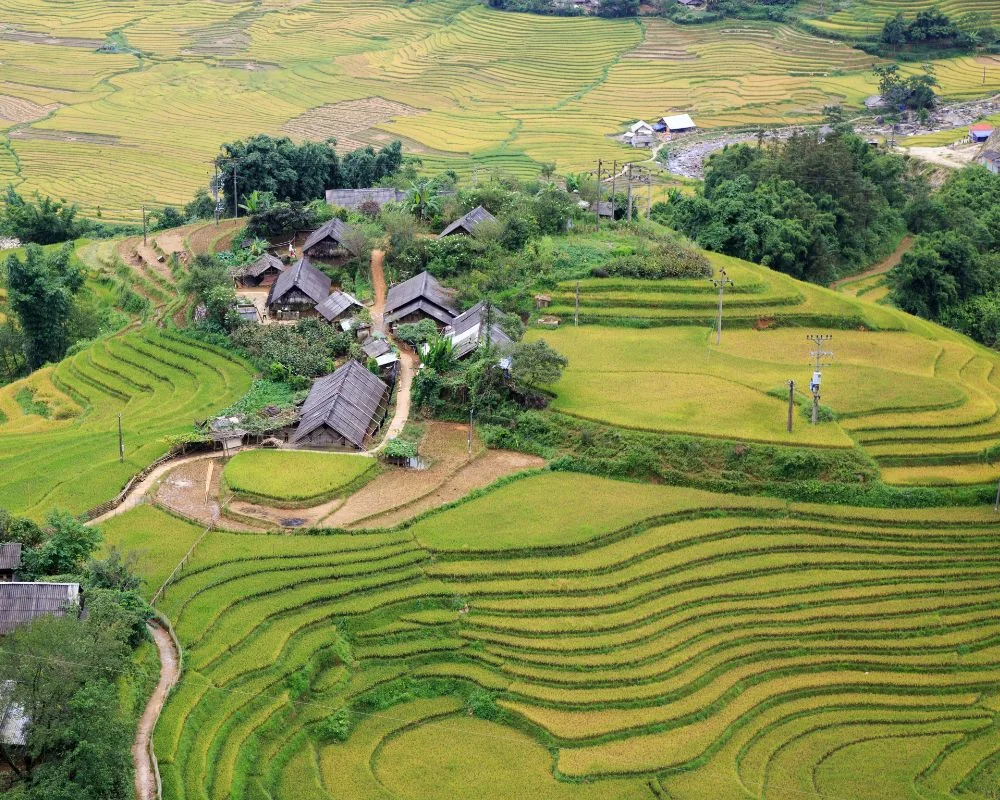
From Hanoi to Sapa
Traveling from Hanoi to Sapa is an exciting adventure. It offers beautiful landscapes and unique experiences. The distance of about 315 kilometers (196 miles) has many transport options for different budgets and preferences.
For those who love scenic views, taking a train to Lào Cai is a great choice. It takes around 8 hours and 20 minutes. The train has comfortable sleeper compartments. After arriving in Lào Cai, a short drive takes us to Sapa’s stunning valleys. Or, we can choose direct buses or limousine minivans, reaching Sapa in 6 hours from My Dinh bus station. Prices are from $10 to $20.
For a quicker trip, a private car is an option. It saves time, reaching Sapa in about 5.5 hours. But, it costs more, starting at around $200.
The choice of transport depends on our time and preferences. Here are some details to help us decide:
| Transport Mode | Duration | Approximate Cost |
|---|---|---|
| Train to Lào Cai + Drive to Sapa | ~8h 20m + 1h | From $18 (train) + additional drive cost |
| Bus or Limousine Minivan | ~6h | From $10 to $20 |
| Private Car | ~5h 30m | Starting at $200 |
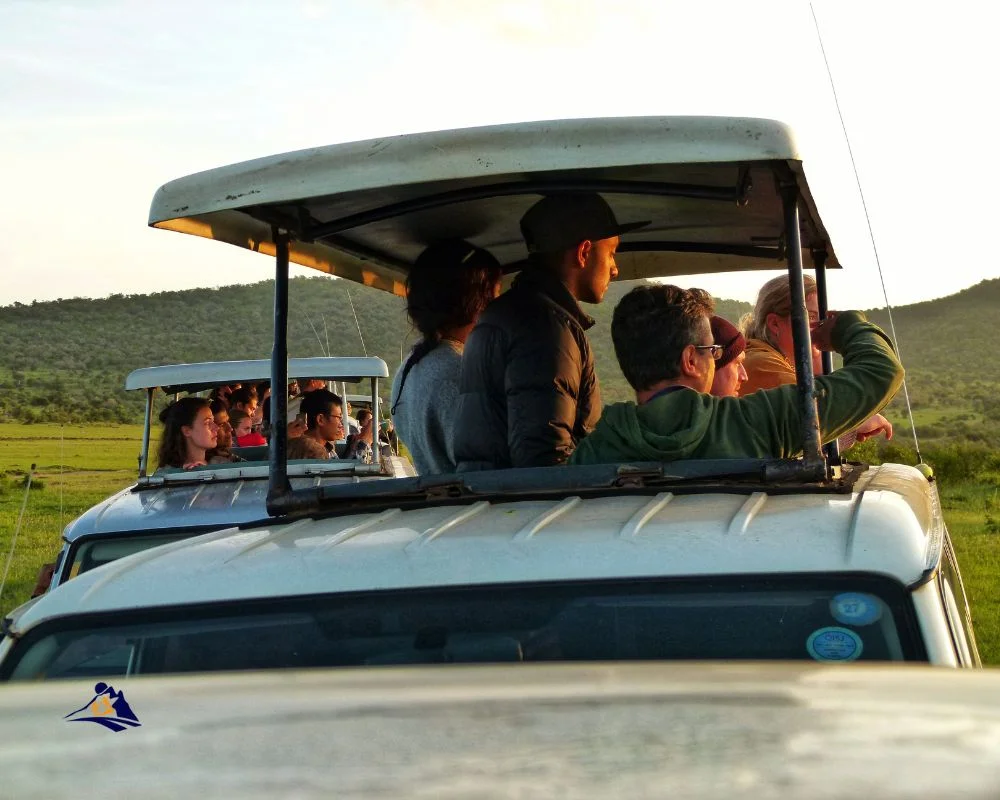
Traveling from Hanoi to Sapa offers many choices for everyone. No matter the choice, Sapa’s beauty makes every journey worth it.
Sapa Transportation Options
Exploring Sapa offers many ways to get around. Walking and cycling let us see the beauty up close. Renting motorbikes gives us freedom to find hidden spots.
For longer trips, taxis and shuttle buses are key. The bus ride from Hanoi to Sapa is about 5 hours. Prices vary from VND 210,000 to VND 750,000, based on what’s included and when you travel.
Minivans are a bit faster, taking around 5.5 hours. They start at $18. Trains take longer, about 9 hours. Ticket prices range from VND 450,000 to VND 2,000,000, depending on the class.
Renting a private car costs from VND 600,000 a day. It’s great for groups or families. Motorbike rentals are cheaper, from VND 120,000 to 200,000 a day. They’re perfect for solo travelers or couples.
For a smooth trip, book ahead and pack for Sapa’s weather. Hiring a local guide can also enhance your visit. With these choices, traveling around Sapa is both fun and easy.
| Transportation Option | Duration | Price Range (VND) |
|---|---|---|
| Bus from Hanoi | ~6 hours | 210,000 – 750,000 |
| Minivan from Hanoi | ~5.5 hours | ~18 USD |
| Train from Hanoi | ~9 hours | 450,000 – 2,000,000 |
| Motorbike Rental | Per day | 120,000 – 200,000 |
| Private Car Rental | Per day | 600,000+ |

Accommodation in Sapa
Traveling to Sapa offers a wide range of places to stay. You can choose from luxury resorts with amazing views to cozy homestays in traditional villages. We can find the perfect spot to relax and dive into local culture. Let’s look at the different types of places to stay in Sapa and some tips for booking.
Types of Accommodation
When looking for a place to stay in Sapa, we have many options:
- 5-star hotels: Places like the Hôtel de la Coupole – MGallery offer top-notch amenities.
- 4-star hotels: They mix comfort and style for a memorable trip.
- 3-star hotels: These are affordable and still offer a great stay.
- Hostels: Perfect for those on a tight budget, they have a community vibe.
- Homestays: Stay with local families for a real cultural experience; highly recommended.
We suggest 10 places to stay, with five in each category of 3-star, 4-star, and 5-star hotels, plus five homestays. This way, everyone can find their perfect place in Sapa.
Booking Tips

To get the best place to stay in Sapa, follow these booking tips:
- Book Early: Sapa is popular, so book ahead, especially during busy times.
- Check Amenities: Look for places with extras like Wi-Fi, breakfast, and spa services to make your stay better.
- Read Reviews: Guest feedback helps ensure the place meets your expectations.
- Think About Location: Staying near Sapa town makes it easier to explore and enjoy local activities.
- Pack Right: Sapa’s weather can be unpredictable, so bring layers and waterproof gear for comfort.
By following these tips, we can have a wonderful time in Sapa. We’ll enjoy all the unique things this beautiful highland has to offer!
Top Attractions in Sapa
Sapa is a treasure trove of sights and experiences. It showcases its rich culture and stunning natural beauty. From majestic mountains to vibrant markets, Sapa has attractions that promise unforgettable moments.
Main Highlights
When planning our adventure in Sapa, we can’t miss these remarkable attractions:
- Fansipan Mountain: The highest peak in Vietnam and the Indochinese peninsula, towering at 3,147.3 meters (10,326 feet). Accessible via the longest non-stop cable car in the world, offering breathtaking views.
- Ta Phin Ancient Monastery: Situated about 12 km from Sapa town, this historic site provides insight into local spirituality and architecture.
- Dragon Waterfall: Nestled within Hoang Lien National Park, a perfect spot for swimming during warm days.
- Sapa Glass Bridge: Standing at over 2,200 meters, it’s the tallest bridge in Vietnam, presenting a thrilling experience with stunning views.
- Silver Waterfall: Cascading from a height of over 200 meters, its silver-like appearance is a sight to behold.
- Cat Cat Village: A glimpse into traditional life, this village charges a small entrance fee and offers a vibrant cultural display.
- Sau Chua Rose Garden: Located about 7 km from Sapa center, ideal for those who appreciate nature’s beauty.
- Topas Ecolodge: Recognized for providing unique experiences, this resort allows us to connect with nature in comfort.
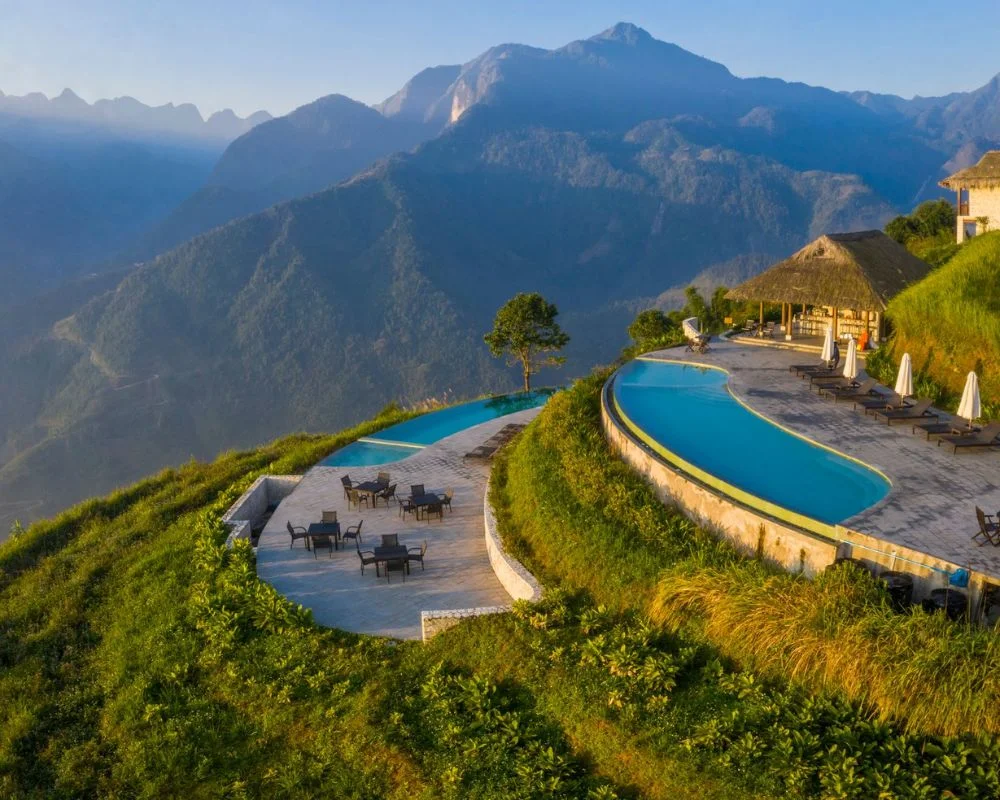
Trekking and Outdoor Adventures
Sapa is a top spot for trekking and outdoor fun. Its beautiful landscapes, with terraced fields and tall mountains, welcome all adventurers. You can tackle Mount Fansipan’s tough climbs or take easy walks through villages.
Popular Trekking Routes
Some of the most loved trails include:
- Ta Phin Loop: A scenic trek with amazing views of the green surroundings.
- Muong Hoa Valley: Famous for its beautiful rice terraces and cultural experiences with local tribes.
- Ma Tra – Ta Phin Villages Trek: A short, 2-3 hour trek, great for a quick adventure.
Tips for Trekking in Sapa
Here are some key tips for a great trek:
- Choose comfy hiking clothes that fit the weather. In July, it’s cool, with temperatures between 18°C and 24°C, and humid.
- Drink lots of water, 2 to 3 liters a day, especially when it’s hot and rainy.
- Don’t forget these must-haves:
| Essential Items | Description |
|---|---|
| Lightweight clothing | Breathable clothes to keep you cool and dry. |
| Rain gear | Keep dry in Sapa’s sudden rain showers. |
| Sturdy hiking boots | Good for uneven paths. |
| Hat and sunglasses | Protect from the sun, even on cooler days. |
| Water bottle | Stay hydrated during your trek. |
| Snacks and energy bars | Quick energy boosts. |
| First aid kit | For minor injuries. |
| Cash | Useful, as ATMs are scarce in remote areas. |
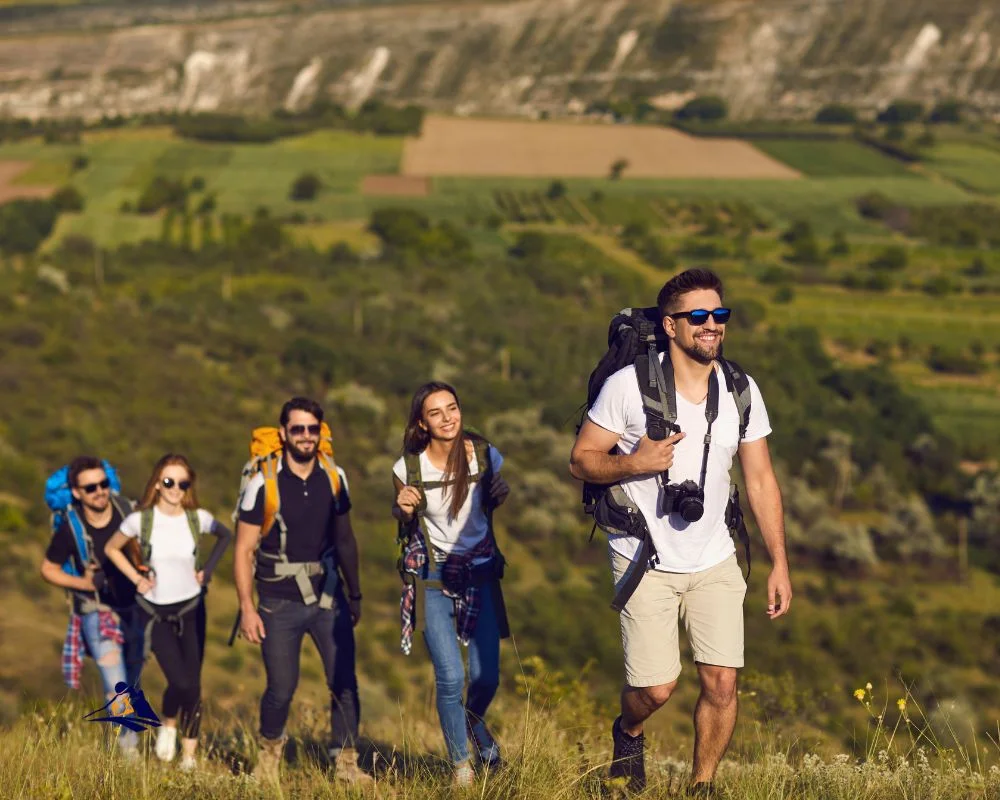
By following these tips and picking the right route, we can enjoy Sapa’s natural beauty and culture. The adventures here will make unforgettable memories.
Exploring Ethnic Villages
Our journey to the ethnic villages in Sapa opens a world full of culture and tradition. Visiting places like Lao Chai and Ta Van lets us connect with the local way of life. These villages, 7 to 12 kilometers from Sapa town, show us the daily life and customs of the ethnic groups.
Walking through these beautiful landscapes, we see traditional practices up close. We see handmade crafts, colorful clothes, and farming routines. This creates a rich atmosphere that deepens our bond with the land and its people. The best times to visit are from February to April and September to October, when the weather is nice and there’s lots to do.
Getting to Lao Chai and Ta Van is easy. You can rent a motorbike for 100,000 to 150,000 VND a day, or a bicycle for 50,000 VND. If you prefer a ride, a taxi costs 100,000 to 120,000 VND. The entrance fees are low, with adults paying 75,000 VND and children’s fees based on age and height.
Exploring these villages in Sapa is full of activities. You can go trekking in beautiful landscapes or join local markets. Every moment is an adventure and a chance to learn about the vibrant traditions of this area.
| Village | Distance from Sapa Town (km) | Entrance Fee (Adults) | Entrance Fee (Children) |
|---|---|---|---|
| Lao Chai | 7 | 75,000 VND | 50,000 VND |
| Ta Van | 12 | 75,000 VND | 30,000 VND |
Sapa 1 Day Tours
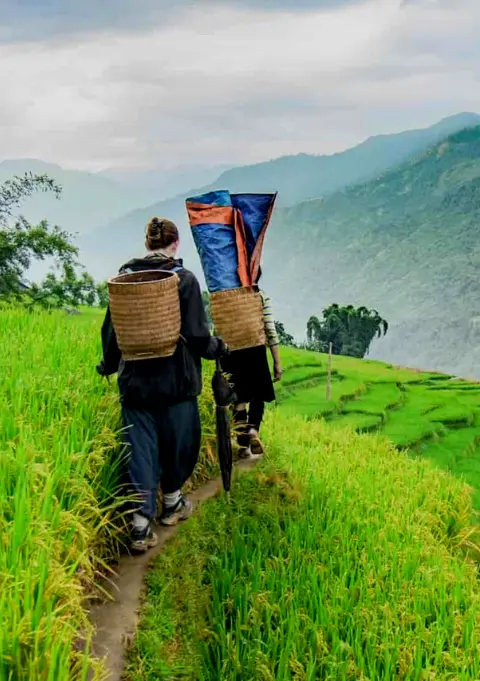
- 1 day experience
- Moderate to challenging
- Cultural immersion & active adventure
- Rice fields, valleys & villages
- Private tours
- Vegan-friendly
Sapa 2 Day Tours
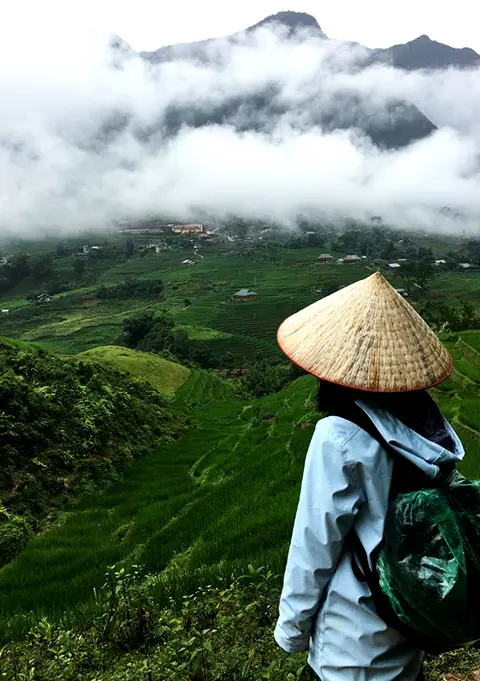
- 2 days 1 night experience
- Moderate to challenging
- Cultural immersion & active adventure
- Mountains, valleys, rice fields and villages
- Private tours
- Vegan-friendly
Sapa 3 Day Tours
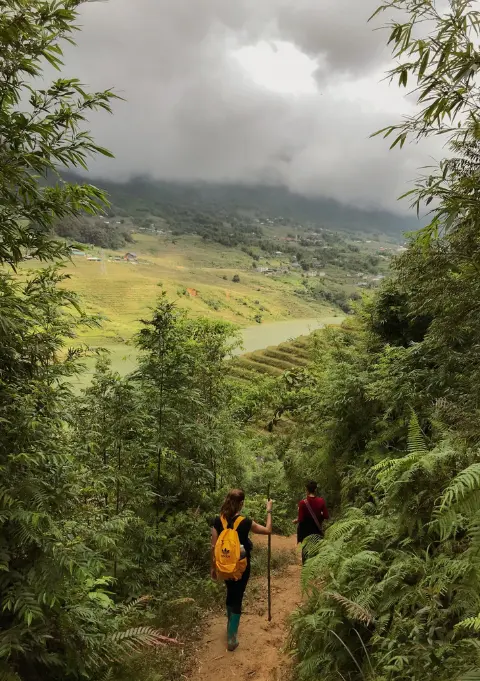
- 3 days 2 night experience
- Moderate to challenging
- Cultural immersion & active adventure
- Mountains, valley, rice fields & villages
- Private tours
- Vegan-friendly
Sapa 4 Day Tours
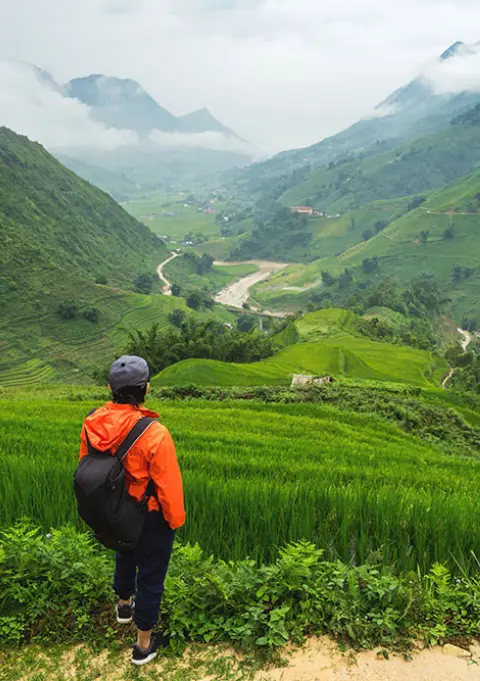
- 4 days 3 night experience
- Moderate to challenging
- Cultural immersion & active adventure
- Mountains, valleys, rice fields & villages
- Private tours – Less Touristic
- Vegan-friendly
Sapa Tour Packages
Exploring Sapa lets us see its stunning landscapes, rich cultures, and fun activities. There are many Sapa tour packages to choose from. These packages offer day treks and deep cultural experiences. We can pick what suits us best.
Tour packages last from 3 to 12 days. The 3-day trips are popular, but longer ones let us explore more. Prices vary a lot. A 3-day tour starts at US$123, and a 12-day trip can cost up to US$2316.
People of all ages can join these tours. They welcome everyone from 1 to 99 years old. Most tours are for people aged 3 to 85. This makes it great for families and all ages. Some tours offer guides in many languages, including English, German, Italian, French, Spanish, and Chinese.
| Feature | Details |
|---|---|
| Price Range | From US$123 (3-day) to US$2316 (12-day) |
| Age Range | 1 to 99 years old |
| Duration | 3 to 12 days |
| Languages Offered | English, German, Italian, French, Spanish, Chinese |
| Satisfaction Rating | 9.2 out of 10 based on 98 reviews |
There are many exciting things to do in Sapa, like trekking and visiting Fansipan Mountain. Guided tours in Sapa offer amazing experiences. Whether you want adventure or relaxation, there’s a tour for you.

Sapa’s Culinary Delights
Sapa food is a unique culinary journey that shows the region’s rich cultural diversity. The Hmong, Dao, and Tay communities add to the flavor of dishes. We dive into Sapa culinary experiences to see local traditions up close.
Dining in Sapa means enjoying fresh, local ingredients. The cool weather and fertile soil make the produce and flavors special. Must-try dishes include:
- Thang Co (Horse Meat Soup) – A local delicacy for adventurous eaters.
- Men Men – Traditional ground corn served in various styles.
- Grilled Skewers – Perfectly marinated meats grilled to perfection.
- Sapa Trout – Known for its natural sweetness, served grilled, fried, or steamed.
- Sticky Rice in Bamboo (Com Lam) – Simple yet flavorful, showcasing local herbs.
Exploring local dining, restaurants like A Phu offer dishes from 25,000 VND to 1,000,000 VND. Viet Home mixes Vietnamese and European cuisines with local flavors in a cozy setting. Cho Tinh Quan is known for H’mong cuisine, like lemongrass salmon and pumpkin-infused black chicken.
The Hotpot Center Restaurant is famous for its salmon hotpot, perfect for communal dining. We enjoy the variety, from vegetarian options at Thong Dong Vegan Kitchen & Cafe to vibrant rainbow trout dishes. Each meal deepens our connection to Sapa’s culture through its amazing food.
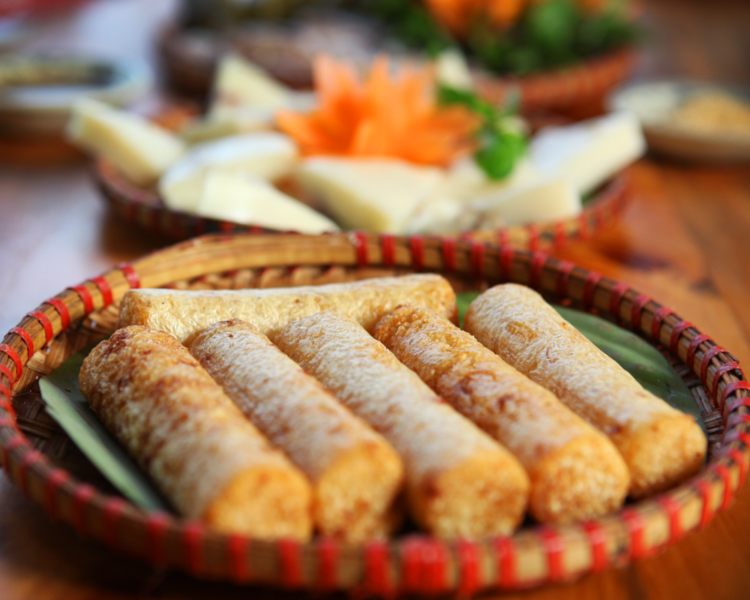
Responsible Tourism in Sapa
Responsible tourism in Sapa is key to keeping its culture and nature safe. By traveling sustainably, we help the local community and environment. It’s important to respect local ways and enjoy the stunning views.
Buying local crafts helps the villagers financially. These crafts show the area’s rich culture and make the locals proud. We must think about how our actions affect the environment.
Eco-tours let us connect with nature and learn about local life. Choosing walking tours in Muong Hoa Valley helps reduce our carbon footprint. Sapa’s beauty attracts many visitors each week.
- Embrace local customs and traditions.
- Support local economies by purchasing handicrafts.
- Engage in eco-tours for sustainable interactions.
- Minimize environmental impact through conscious travel choices.
- Explore cultural sites, like Cat Cat village, respectfully.
Let’s make sure our tourism in Sapa is responsible. This way, we help both travelers and locals, making our journey special.
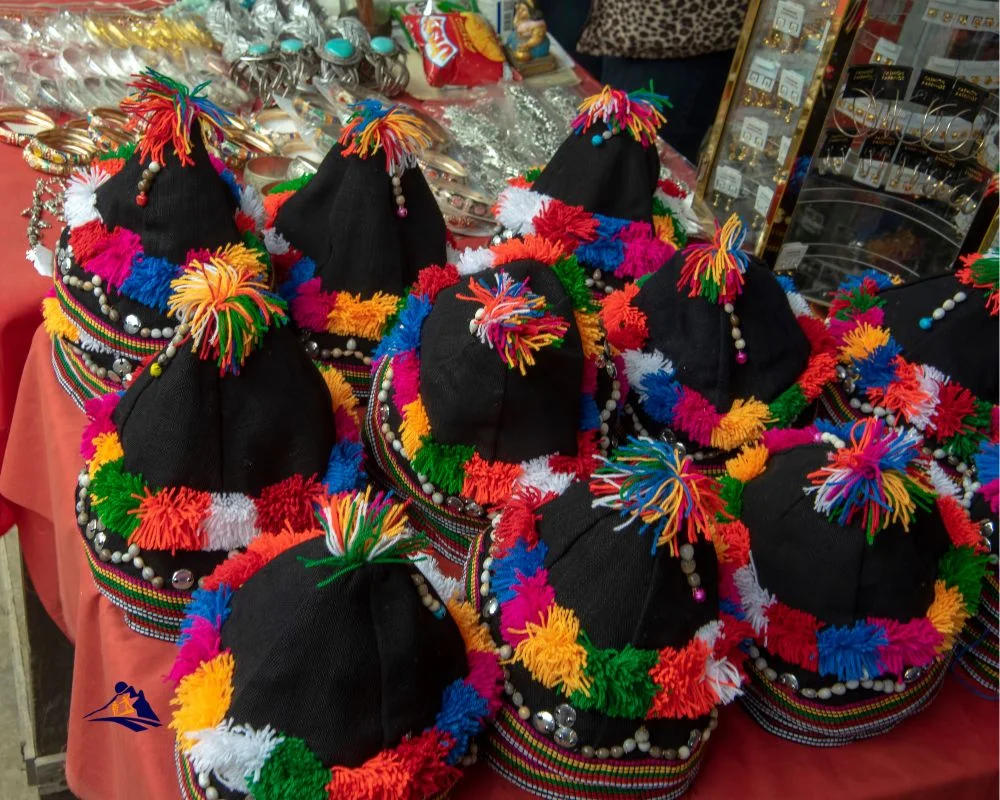
Conclusion
Sapa is truly mesmerizing. Its stunning landscapes, rich traditions, and vibrant culture make it unforgettable. Trekking through rice terraces or trying local foods, every moment is filled with wonder.
A well-planned 5 days 4 nights tour lets us dive into local life. We join in on traditional rituals and visit the Bac Ha market. These experiences deepen our connection to this special place.
Sapa is not just a place to visit; it’s a chance to connect with nature and culture deeply. For more on planning your trip, check out this link or see suggested itineraries at this resource. Let Sapa’s adventure create memories that last a lifetime.
Sapa 1 Day Tours

- 1 day experience
- Moderate to challenging
- Cultural immersion & active adventure
- Rice fields, valleys & villages
- Private tours
- Vegan-friendly
Sapa 2 Day Tours

- 2 days 1 night experience
- Moderate to challenging
- Cultural immersion & active adventure
- Mountains, valleys, rice fields and villages
- Private tours
- Vegan-friendly
Sapa 3 Day Tours

- 3 days 2 night experience
- Moderate to challenging
- Cultural immersion & active adventure
- Mountains, valley, rice fields & villages
- Private tours
- Vegan-friendly
Sapa 4 Day Tours

- 4 days 3 night experience
- Moderate to challenging
- Cultural immersion & active adventure
- Mountains, valleys, rice fields & villages
- Private tours – Less Touristic
- Vegan-friendly
